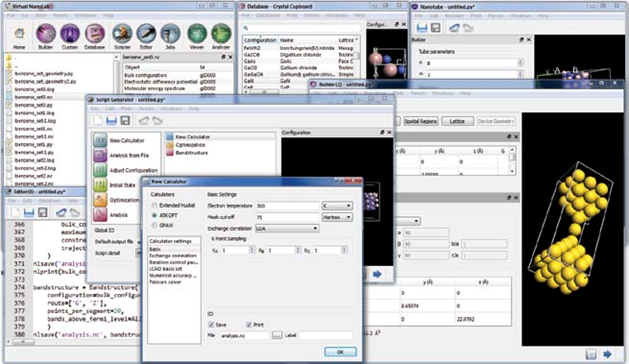These programs are very popular, but they lack a great front-end. Virtual NanoLab can now solve this issue. It’s now possible to create advanced structures using an interactive, high-performance 3D atomic builder, and then automatically create ready-to-run output files for any other code. With a pair of interactive instruments that permit users to design nanosystems as well as set up and perform numerical calculations. A powerful application utilized for the simulation of, modeling, and evaluation of physical and chemical properties of nanoscale devices. Get More Softwares From Getintopc
Password 123
Virtual Nanolab
The features are applicable for both bulk semiconductors as well as nanostructures and 2D materials such as graphene. QuantumATK helps accelerate semiconductor and material R&D and decreases cost and time by enabling more efficient workflows during the process of screening new materials across a wide spectrum of industries that are high-tech. With its graphic design, Virtual NanoLab provides a user-friendly way to model atomic scale. The program includes a collection of interactive instruments that allow users to create nanosystems, create and run numerical calculations, and show the outcomes. Materials such as nanotubes, molecules, crystal systems, and two probe systems (i.e. the nanostructure that is connected by two electrodes) can be constructed with just only a few mouse clicks.
Virtual Nanolab Features
Atomistix Virtual NanoLab is a commercial point-and-click program for the analysis and simulation of chemical and physical characteristics of devices at the nanoscale. Virtual NanoLab is created and sold through QuantumWise A/S. QuantumWise was bought by Synopsys in the year 2017. The Virtual NanoLab using Atomistix ToolKit is an all-purpose atomic-scale modeling platform that incorporates many different techniques and models that could be utilized to investigate electronic structure… … Incorporating noncollinear spin allows calculations on spin-transfer torque as well as other characteristics that are associated with magnetic tunnel junctions important for MRAM devices as well as various other Spintronics applications.
It comes with 3D visualization tools and Nanoscope, which displays geometrical atomic shapes and the calculated results. Optimize the material choices in the fields of polymers, glass, metals batteries, solar cells catalysis, and many other industries. Explore and simulate a vast spectrum of both basic and advanced materials and their properties as well as systems.

VNL is a simple graphic user interface that simplifies carrying the work, while the Python programming interface permits skilled users to effectively execute complex workflows and conduct sophisticated analysis of data. VNL is also an interface that can be used independently to other programs, offering the capability to create geometries and calculate calculations, and display the outputs generated from VASP, ABINIT, QuantumEspresso as well as others.
Thus, Virtual NanoLab and the Atomistix ToolKit for Linux have an easy-to-use interface. Additionally, in general, it is equipped with a 3D visualization tool together with Nanoscope where the nucleus geometries are computed as well as the results. It is particularly, Atomistic modeling is truly an extensive understanding of the process at the atomic level, which results in the RandD process being very efficient, with high-quality effects.??
Users can also extend the functionality and interfaces offered by the application by creating their own plugins that support different file formats, mix the data and display it in various ways, design different types of structures, and the list goes on. Virtual NanoLab comes with the 3D visualization tool the Nanoscope which displays atomic geometries and the computed results can be examined and visualized. It is possible to, for instance, draw Bloch properties of nanotubes as well as molecules, crystals, and crystals electron densities, as well as the effectiveness of potentials. The numerical engine that carries these simulations Atomistix ToolKit, which combines density functional theory with Green’s non-equilibrium functions for the ab initio electronic structure as well as transport calculation.
How to Get Virtual Nanolab for Free
Atomistix ToolKit is developed from the codes used in academic research TranSIESTA as well as medical. In the same way, Virtual NanoLab + Atomistix ToolKit for Linux is an outstanding program that is utilized for the simulation and modeling, as well as the evaluation of the physical and chemical characteristics of nanoscale devices. It’s also equipped with two interactive instruments that allow users to study nanosystems and to set up and run mathematical calculations.
Manage risk from software with the speed that your business requires. If you’re in an office or on a shared network, you may ask the administrator of your network to conduct a scan of the network searching for malfunctioning or infected machines.
In fact, you can also lookup Bulk Rename Tool 2021. QuantumWise launched a new version of the Atomistix ToolKit simulation application. The new version boosts simulation speed by 40%. Apart from the performance enhancement it also includes a number of new features. The ATK 2014 release has a variety of new features, including Meta-GGA and spin-orbit interaction for accurate prediction of the first principle of electronic structures.
Improve your research with effective atomistic material as well as electronic device simulations with innovative, state-of-the-art methods. Simulate the properties of materials, interfaces, contacts, and stacks for insight into the impact they have on electronic devices as well as processes prior to when the data from wafers are made accessible.
Virtual NanoLab is a GUI for much different code. The application functions as a user interface graphical for Atomistix ToolKit, FHI aims, VASP, QuantumEspresso, LAMMPS, GPAW as well as other programs. So, you can manage all your simulations in one place. QuantumWise has also updated the Virtual NanoLab and expanded it to function as a visual user interface for other applications such as VASP, Quantum Espresso, and LAMMPS.
Virtual Nanolab System Requirements
- Operating System: Windows 7/8/8.1/10
- Memory (RAM): 1 GB of RAM required.
- Hard Disk Space: 300 MB of free space required.
- Processor: Intel Pentium 4 or later.
